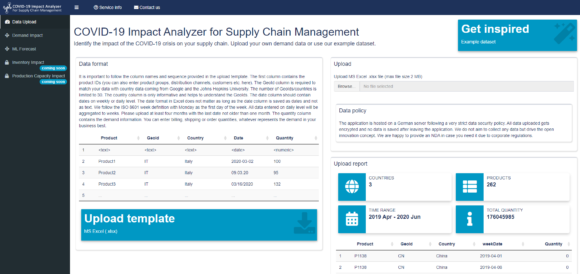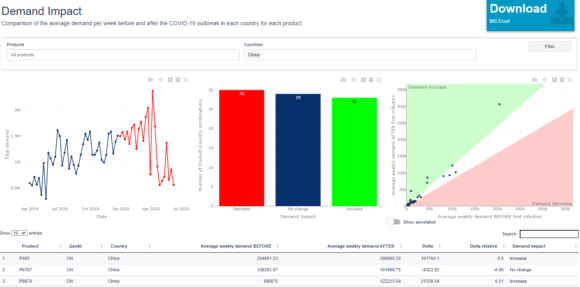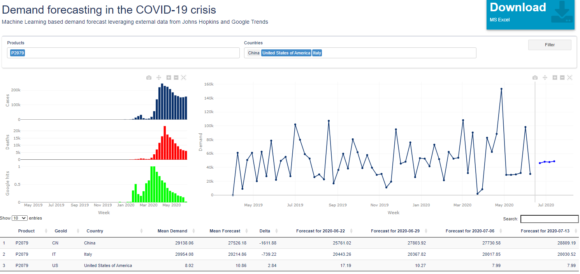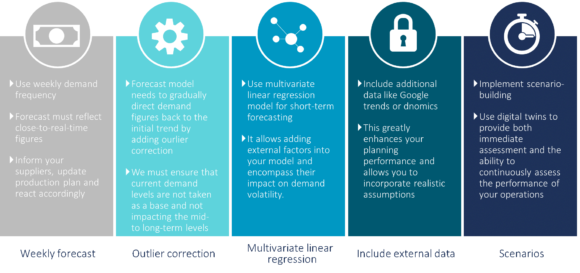How a forecast analytics solution can help demand planners and forecast analysts create stable baseline forecasts in uncertain COVID-19 times.
In our last article we outlined how to master the coronavirus pandemic in demand planning, i.e. what activities to prioritize in the short-term and where to focus in the long-term. Today, we want to take a look at the statistical forecast, also called baseline forecast. A stable and accurate statistical baseline forecast is the key input for every demand planning process. It reduces the manual planning efforts for your sales force and allows them to concentrate on securing and increasing the topline. In these uncertain times, univariate time-series forecasting is no longer enough to create a stable and accurate baseline forecast. In this article, we explain why in times like these, external factors need to be considered in statistical forecasts and how a support tool can help forecast analysts and demand planners to navigate the crisis.
Limitations of univariate time-series in the corona crisis
There are three main reasons why univariate time-series analyses fall short in uncertain corona times:
- Slow motion. Traditionally, univariate time-series models have been a preferred choice, because such models need only one variable and forecasting can be done fast. Runtime is important when you need to react very quickly to new information (for example, predicting stock prices on the financial markets) or process large amounts of data (for your portfolio of thousands of different SKUs). However, the runtime advantage of univariate models has been challenged as of late. In fact, during the corona crisis, companies that relied solely on the univariate time-series models had to spend a lot of time on manual adjustments to their model outputs.
- Own historical perspective. You are projecting the behavior of a time series only on its own past, but not on any other series. Here you potentially miss important causal modeling or representations of true relationships among available variables. For a retail company, simply adding a variable representing its closed stores to their demand analysis could already provide a great benefit to the time-series model performance.
- Continuous review. Using univariate time-series models in an environment that changes so rapidly causes planners to continuously review their estimates, preferably even on a daily basis. Such models lack at least one additional explanatory factor that could encompass such variations and ensure fewer revisions.
All these limitations can be avoided by turning to a different modeling setup, such as multivariate analysis. In addition to adding more company relevant data, you could also consider inclusion of external data into your model.
Importance of additional internal and external data in forecasting
As it has been highlighted in our article on Next-Generation Demand Management, companies need to move to the next level in demand management in order to more effectively anticipate changes in a volatile environment. The COVID-19 pandemic has boosted the volatility of the current market environment, which we must consider in our demand planning initiatives. Adding internal and external data in forecasting is a viable solution when facing unexpected and unstable demand patterns.
Best practice examples suggest that the forecasting model should include internal drivers that the company is aware of and has some degree of control over. Such examples could be production cost factors, product sales price or promotions. Another category would encompass external market factors such as industry investment levels or other macroeconomic indicators that have a lagged effect on the demand levels and can be used in the multivariate forecasting analysis. The combination of these factors explains the demand variability in a very good manner and reaches great results.
The spred of COVID-19 across different geographies has been impacting demand variability severely. Short-term models that help us to understand the real impact of the coronavirus on our demand figures and to produce more robust results, must certainly incorporate external data. One way to do so is establishing short-term forecasting which utilizes latest data, for instance, from Johns Hopkins University or Centers for Disease Control and Prevention, that track the coronavirus outbreak. Another important factor could be adding more data from your ecosystem and supply chain that would capture quasi-real-time demand shifts and related supply shortages – point of sales data, available inventory, capacity constraints etc.
Next, your mid-term forecast must be based on different scenarios and your potential answer to each option, no matter how massive the degree of disruption could be in the worst case. We are operating in uncertain times where demand could show completely wild figures, supply is uncertain and capacity constrained. Unlike previously, demand planning must be run much more frequently and decision-making needs to be super-fast.
At this point, forecast analysts are the enablers and tools like the COVID-19 Impact Analyzer are needed to build scenario-forecasts or even probabilistic forecasts.
For those who have not implemented external data for forecasting yet, Figure 1 presents a useful checklist on how one could proceed. In addition, we highly recommend using a tool such as the CAMELOT COVID-19 Impact Analyzer for Supply Chain Management that incorporates external factors into forecasts and thus helps demand planners successfully navigate the crisis.
Figure 1 Checklist of demand planning in corona crisis times
Why exactly did we create the Analyzer, how does it work and what are the benefits?
WHY First of all, why did we develop the Analyzer? We want to support our clients and other companies in these difficult times by providing a free-of-charge innovative solution to better analyze the impact of the COVID-19 crisis on supply chains. For us as supply chain experts, now is the time to share our knowledge to help others in keeping supply chains up and running as well as to support the concept of open innovation.
HOW Secondly, it is important to understand how the Analyzer can support forecast analysts, demand planners as well as other related functions in forecasting. Currently, many companies are in the middle of special coronavirus meetings and struggling to make data-driven decisions responding to this crisis. Instead of interviewing sales experts and manually adjusting detailed plans, the COVID-19 Impact Analyzer can quickly give fact-based insights on demand individually per product-country – before and after the first COVID-19 outbreak. These results lay the foundation for further supply chain scenarios and planning. They will help companies to respond to the daily changing situations. Moreover, the Analyzer can create a short-term forecast for the upcoming four weeks based on latest machine learning algorithms.
WHAT Finally, what is achieved by the COVID-19 Impact Analyzer and how does it work? It is a ready-to-use data science solution based on R & Shiny. This setup has been proven by multiple customers to rapidly build web applications that are very intuitive for users and help to quickly generate data-driven insights. To make use of external data sources the application not only utilizes historic sales data but also employs real-time data from Johns Hopkins University as well as Google Search Behavior. This enables us to use machine learning algorithms to create a very precise short-term forecast.
Let’s have a quick look on how to use the Analyzer:
- Users need to upload historic sales data on a product-country level in weekly buckets stored in an Excel file. After the upload the users receive an overview report on what they have uploaded as well as an error handling report in case something went wrong.

It is important to note that CAMELOT does not save any of the uploaded data. It is immediately deleted after the user leaves the system.
- In the Demand Impact screen users can analyze the demand before and after the coronavirus pandemic. This shows us how the demand pattern has been affected and if there was any significant change to the usual behavior. The results can be directly downloaded to be further utilized in your daily work.

- In the Demand Forecasting screen, the users are now able to generate machine-learning-based forecasts. The main drivers that our algorithm considers besides the sales data are the cases and deaths as reported by the Johns Hopkins University as well as the Google Search Behavior for every country individually. Based on these factors a short-term forecast is generated for every product-country combination. The results can be directly downloaded as well.

Demand planners are confronted with the impacts of this pandemic and will continue to work through the urgent obstacles they face. Organizations are learning how to better plan, predict and reduce the extent of disruptions by developing the capacities required to respond with pace and certainty to future events. We are convinced that our COVID-19 Impact Analyzer will help you to navigate these uncertain times and we invite all to start using it straightaway.


